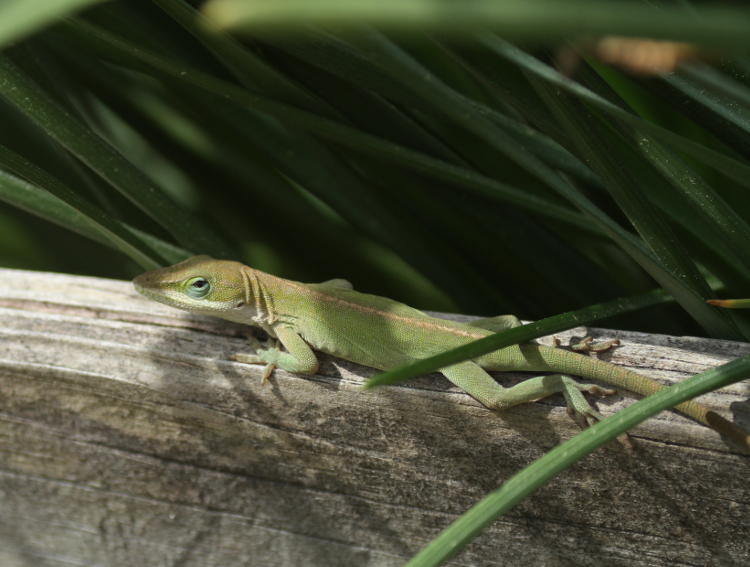
I’ve mentioned in two previous posts about a trip to the NC Botanical Gardens, a session The Girlfriend and I did before their closing, and I would have warned you about the closing had I had more than a day’s notice myself. Note that this just applies to the gardens proper; the nature trails out back remain open.
Anyway, I was hoping to see at least a Carolina anole (Anolis carolinensis,) which can often be found in the garden but I wasn’t sure if it was a little too early yet, the warm temperatures still fairly new. The activity that we found was not just gratifying, it was better than any previous trip, so I’m counting this one as successful. Above, the first anole in evidence scampered warily along a fenceline, pausing just for a moment as I loomed in closer to get the detail shots, then slipping around behind to avoid us. With typical behavior, though, it peeked out to see if we’d moved on, and I was ready.

I have a few frames like this, shot within about three seconds, with subtle differences as the anole surveyed the surroundings – I was holding still, except for the index finger twitching on the shutter release. This frame, however, conveyed more of a sense of horror, solely from the eye position because expressions on reptiles really don’t change.
Not even a minute later, I was examining the palmlike plants (I can’t recall their name and am not wasting more time looking) that the anoles prefer the most, and found another one, providing a fetching pose that I particularly like.
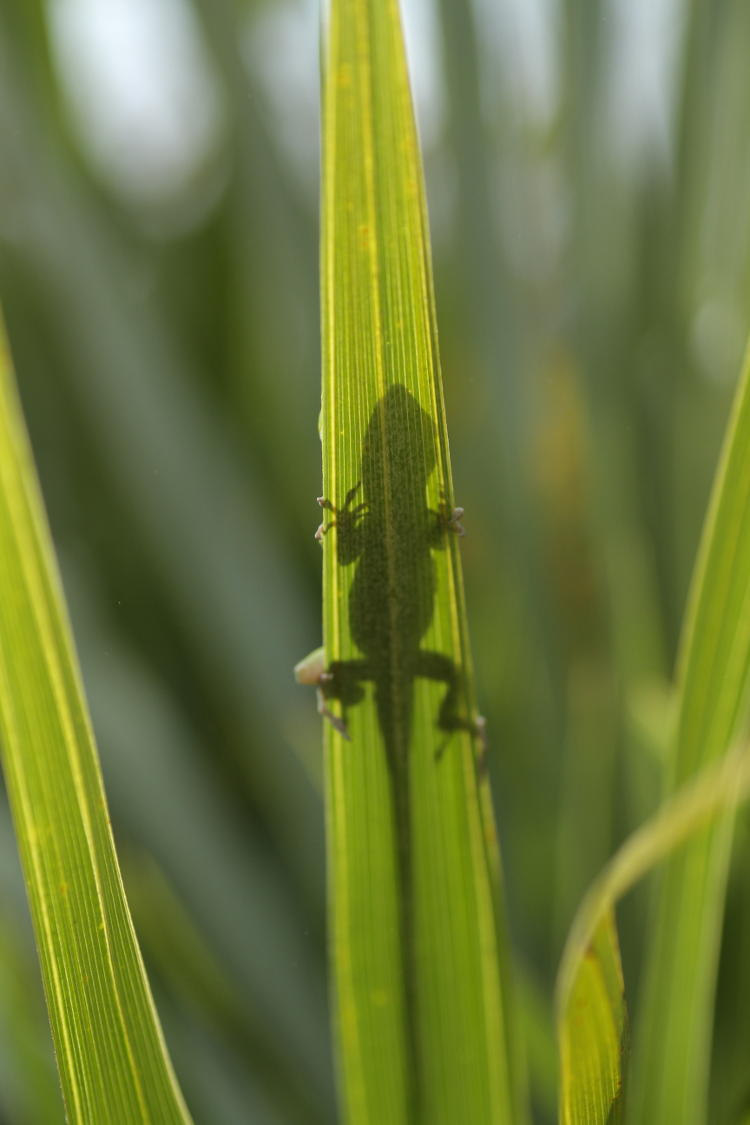
I just like the idea that the lizard was doing its best to camouflage itself while getting some sun, but in a way became more obvious, at least when seen from this angle. Still, most people blow right past displays like this, never paying close attention and already having considered the kindapalms as ‘uninteresting’ – they have no flowers, after all. Their loss, of course (the unobservant people, not the unpalms.)
Meanwhile, my subject knew we were there and peeked out to check on us.

I get the impression of a reptilian carpenter checking the accuracy of their cut. But maybe that’s just me ’cause, you know, lizards have no expression. This is a tight crop of the original, partially because the semipalms made me keep my distance (the anole being more to the center of the plant,) but we really needed to see the scale detail here, and that shading ridge ahead of the eye.
Elsewhere in the garden, a skink was also checking out the lovely day.
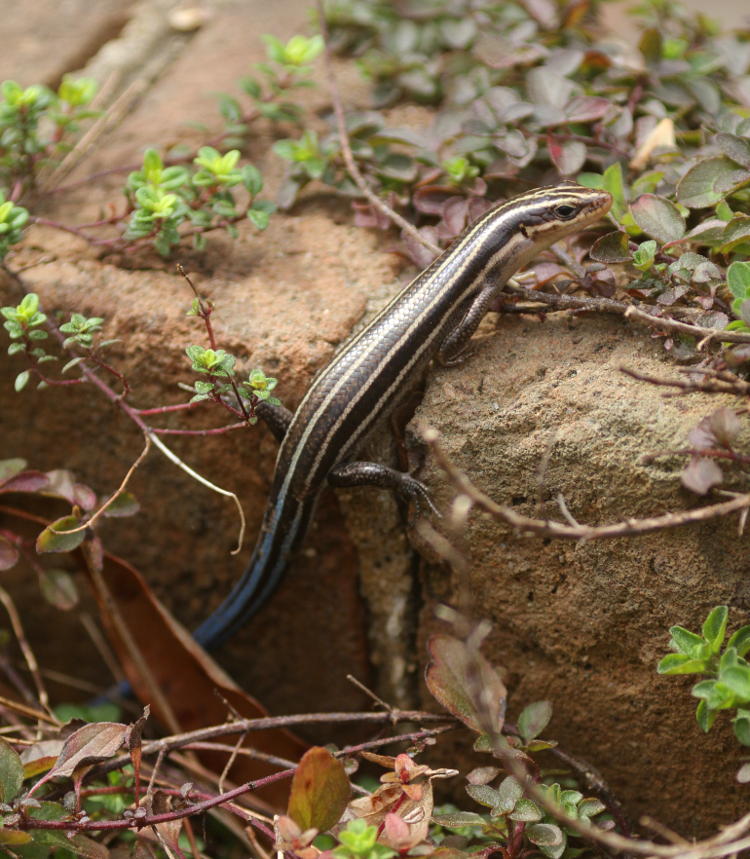
This is an American five-lined skink (Plestiodon fasciatus,) which make occasional appearances in our own yard, at least one living within the bricks of the front porch – I mean, probably not this one, but one of the same species. I would like to convince the anoles to come live here but have no idea how to do that, short of catching a few and introducing them, but I’m not sure the habitat is what they’re after. The skink here was reasonably mellow and I was able to switch sides of the planter and go in for the portrait while the skink struck a no-nonsense board meeting pose.
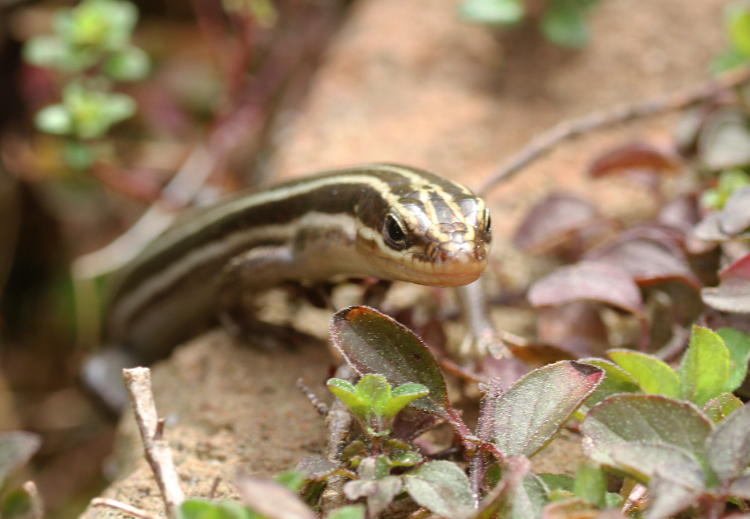
No, that’s just silly; reptiles don’t have expressions. I think I heard that once.
As we’d entered the garden, I expressed my intentions to look for lizards and snakes, even though the snakes tend to be few and far between within the gardens themselves, and The Girlfriend remembered a previous visit and suggested we check out the walls of the gift shop and plant sale area. The shop was closed and the plant shelves empty, but as we approached, she pointed ahead and said, “There you go.” I looked in the indicated direction and saw another anole scampering around the empty tables, so I crept in for a few more frames. After a minute or so, she inquired rather sharply as to what I was doing, and when I told her I was shooting the anole that she’d pointed out, she corrected me with amusement; she hadn’t meant the diminutive lizard (which she’d never seen,) but the nigh-two-meter black snake sprawled across the walkway in plain sight beyond it, already attracting the attention of two other photographers. Remember what I said about people missing the small details? No? Good.
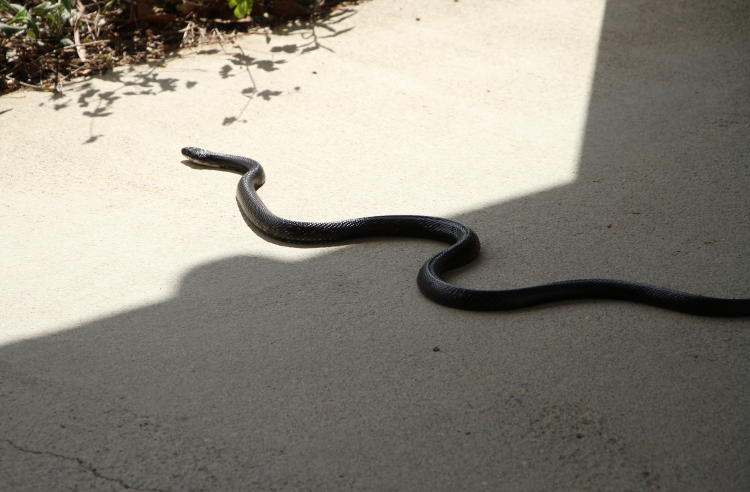
Black rat snakes (Pantherophis obsoletus) are the largest snakes in the region, and this was the largest I’ve seen in years, perhaps just shy of my own body length and as thick as a garden hose. The other photographers told me it had emerged from along one wall and was making its way unhurriedly across the middle of the garden public area, but there were few visitors so it was remaining mostly unnoticed. Eventually, it slipped casually into a planting bed with thick undergrowth and largely disappeared from view while I maneuvered around for more of a head shot. I was just remarking that we wouldn’t see much unless it decided to rear its head, which I considered unlikely due to it foraging for food species, when it reared its head. Well, fine – happy to be wrong.

The scattered clouds abruptly parted for a few moments, providing some nice distinct light for some shine on the scales, and the snake sampled the air with its tongue several times as we watched. The image above is better for the angle on the head, but the one below shows the tongue better, so I’m providing both.
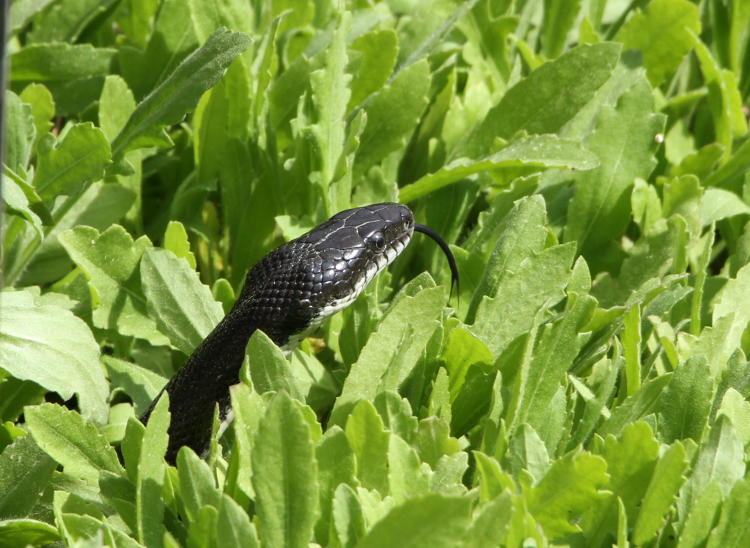
I had to crop these pretty tightly, because it emerged right alongside one of the many plant identifying signs throughout the garden that I found distracting. After a moment, the snake slipped back down and disappeared from sight with elaborate casualness.
Just a little beyond that The Girlfriend stopped, having seen some movement and unsure if it was a leaf on the gusty day. Then she confirmed her suspicions and pointed out another Carolina anole on the ground alongside some plant pots. I came up from behind and did a couple of frames, noting the color change that helped it blend into both the gravel walkway substrate and dried leaves in the area.
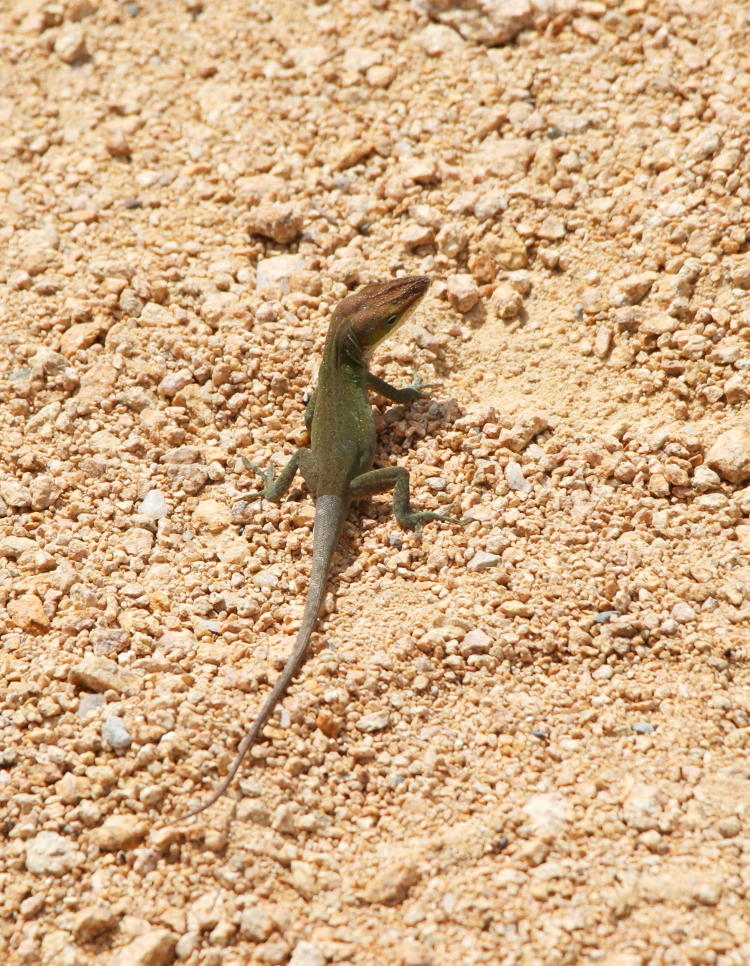
You can see the distinct demarcation at the base of the tail, and I had a vague impression of an incompletely shed skin like I’ve seen before, but other images (getting ahead of myself a tad) show it to be a clear line everywhere, and I’m thinking it’s a new tail that replaced one dropped/taken during an encounter with a predator.
The anole paused for a moment, then scampered quickly across the open area towards a region of shadow near a bench, and we dismissed it. We hadn’t left the immediate vicinity though, and were discussing the various trees in bloom when we spotted it atop the bench. I was thinking that the reptile had scaled it with remarkable speed when I saw another down on one of the legs, which was the first we’d seen; the one atop the bench was another anole altogether. This was worth pausing for, to see if they’d even notice each other, and whether we’d see some mating or territorial behavior if they did.
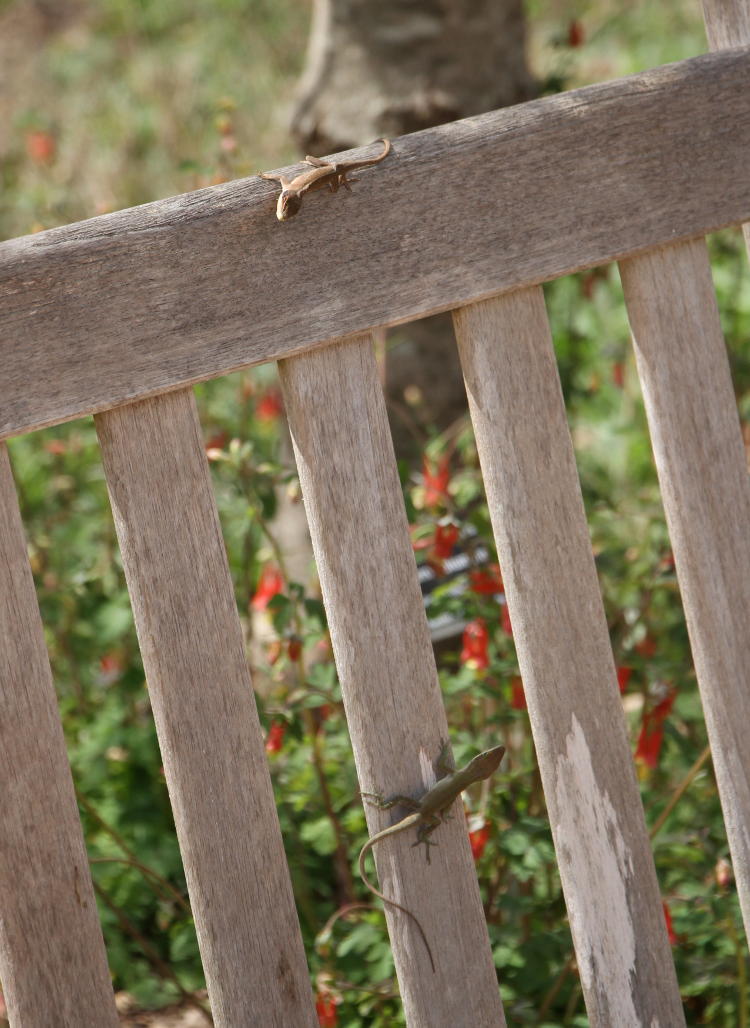
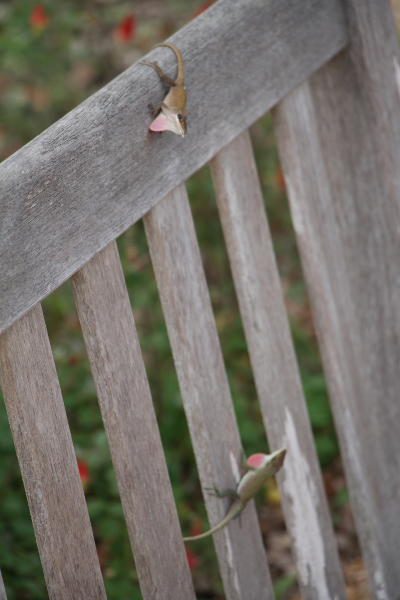 We were not disappointed.
We were not disappointed.
It seems possible that the first that we’d seen had spotted the second, on the bench top, from some distance away and was hurrying to dispute the land claim, but I’m not sure how good their distance vision is. They drew within range and quickly commenced their dominance displays, which consist of head-bobbing and repeatedly flaring their dewlaps, the bright pink semicircle under their chins. Neither one had any intention of backing down, and pretty soon they were drawing closer together and circling warily. Ourselves, we weren’t budging a millimeter.
[The autofocus, up until then behaving as intended, now tried to lock onto the background flowers through the slats of the bench, so I quickly switched to manual for a bit but didn’t quite nail focus on the wider shot at right, so this is as large as I’m making it. They get better, though.]
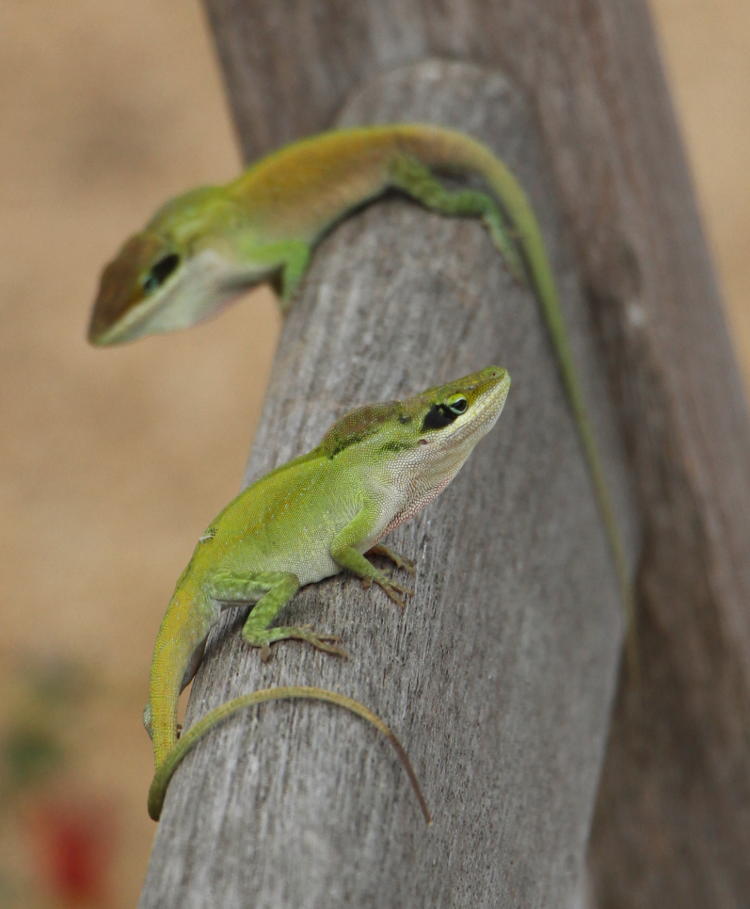
Notable now was the change in coloration, especially the dark spots behind the eyes, and the raising of the crest on their head and neck, both something that I don’t think I’ve ever seen before. I’ve watched very brief territorial displays where one quickly concedes to another without altercation, but this was not to be the case today, and I switched over to video mode.
And a quick still frame, between video clips, of the victor looking smug. No, that’s ludicrous; reptiles don’t have expressions. I suspect that’s urine staining the bench from when the loser was seized bodily and thrown (momentarily) from the ring.
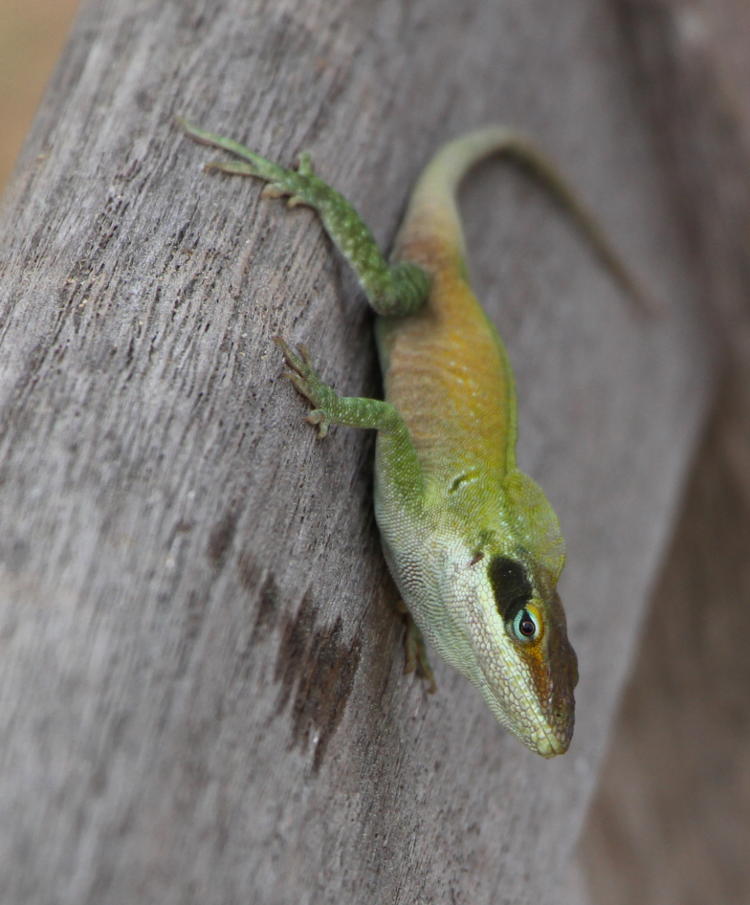
By the way, this is the one we first saw, with the discolored tail, which was ever-so-slightly larger than the other, and the victor of all encounters. I cannot say if it took ownership of the bench away from the other, or discovered an interloper on its own territory while on the ground some meters away, and the second was not easily convinced to give up, but eventually the matter was settled. While this was going on, I managed some detailed frames of the color display from the larger one.
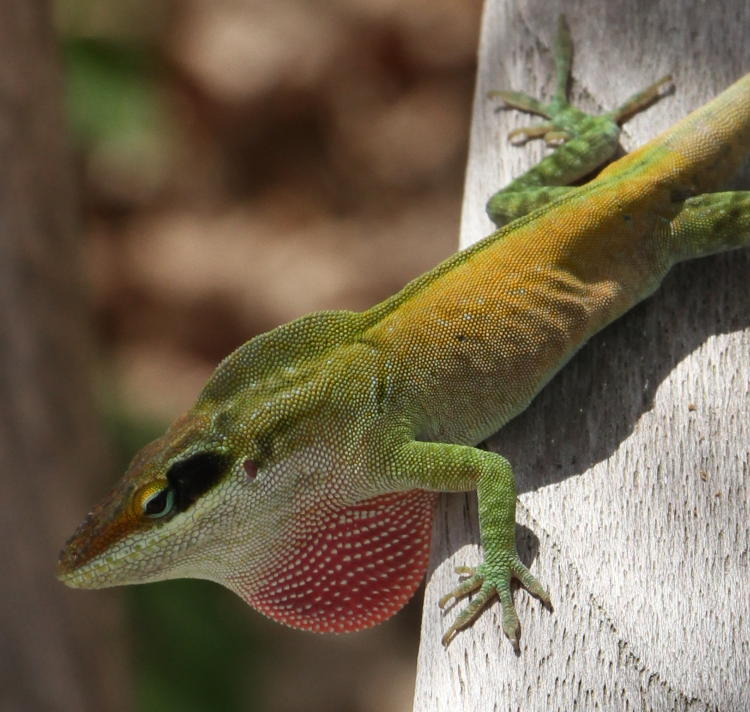
The dewlap is obvious of course, the crest slightly less so, but I want to point out the rust-to-brown color on the head, the mottled stripes on the legs, and of course the eye spot. I may have mentioned, sometime in the distant past, that reptiles don’t have expressions, but that’s patently untrue. They don’t have expressions like we expect to see, but these colors definitely communicate intent and/or mood, and in an encounter with a notably smaller specimen they likely say, “Get lost,” very well, though they’re seen as a challenge to another that’s of comparable size.
We had seen plenty by this point, including some flowers, and started making our way back to the exit, but the reptilian gods weren’t done with us. On a small wooden bridge just ahead of us in the quiet garden, a juvenile fence lizard was basking, remaining largely motionless even as I knelt painfully (that substrate gravel gets everywhere and digs into one’s knees) nearby for a better angle.
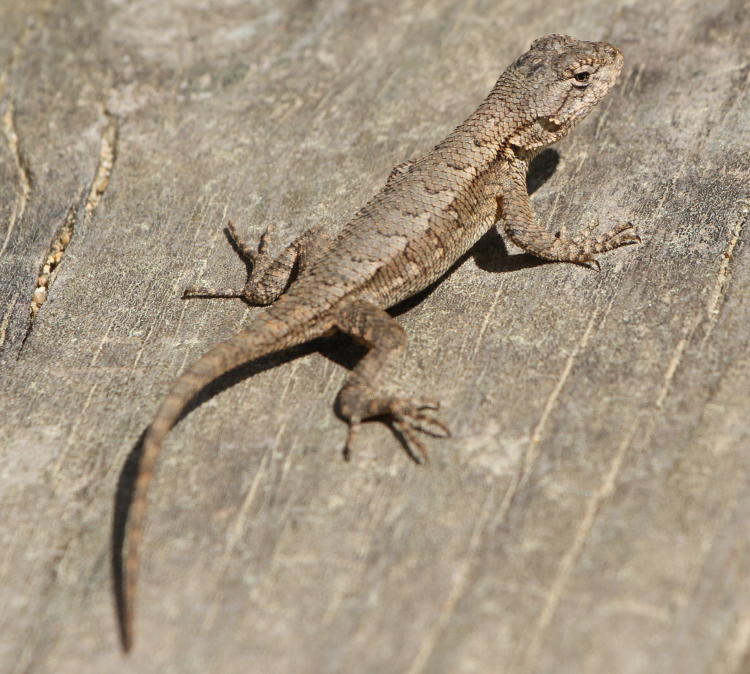
Eastern fence lizards (Sceloporus undulatus) do not seem to be as numerous in the area as skinks or anoles, but they’re both quite shy and remarkably well camouflaged for their favored habitats, so it’s possible that they’re too easy to miss while numbering much closer to the others – I know I hear plenty of sudden rustles not far from the path when hiking, which could easily be one getting under cover. This one was only about ten centimeters in overall length, counting that tail, and they can get many times this mass as adults. They have a pleasantly spiky sharp appearance but their skin isn’t really sharp – biting is more of their defense when it comes to personal encounters. And because I’m here, I’m including a couple of images from way back that I sized for blog use but never used then, because this post is kinda thin on expressive reptile portraits.
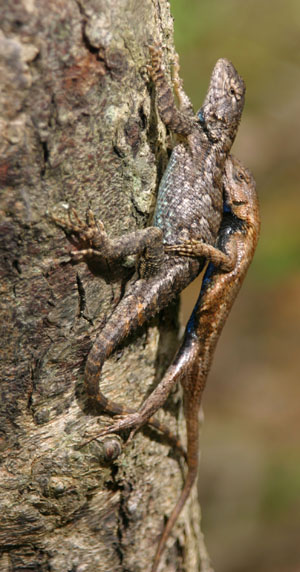 This is a mating pair, snagged in action while out at Duke Forest, if I remember correctly, and it shows off their peculiar electric blue belly scales a little – what purpose these serve I can’t say, but they’re almost impossible to see in any normal circumstances. The one benefit to spotting fence lizards is that they rely on their camouflage a lot, knowing that movement can attract more attention than appearance, and with a slow approach you can sometimes get within great photographic range.
This is a mating pair, snagged in action while out at Duke Forest, if I remember correctly, and it shows off their peculiar electric blue belly scales a little – what purpose these serve I can’t say, but they’re almost impossible to see in any normal circumstances. The one benefit to spotting fence lizards is that they rely on their camouflage a lot, knowing that movement can attract more attention than appearance, and with a slow approach you can sometimes get within great photographic range.
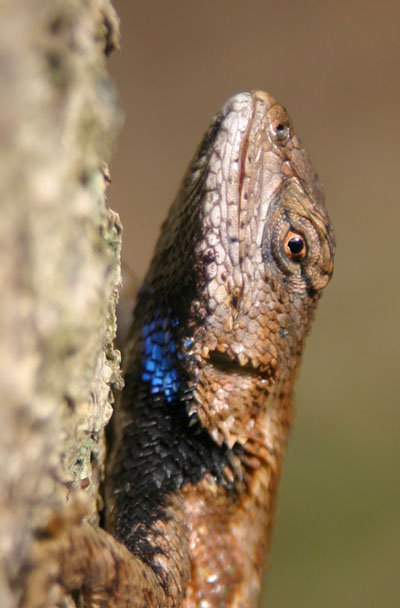 And another. These were both taken on the same outing in May of 2010, but at different times during the day I think. Again, great textures and that splash of brilliant blue, not something that you expect to see from just about any species in this country. Maybe it’s just a vanity thing, the only color they can get away with while still avoiding hawks and crows. Yeah, that’s probably it…
And another. These were both taken on the same outing in May of 2010, but at different times during the day I think. Again, great textures and that splash of brilliant blue, not something that you expect to see from just about any species in this country. Maybe it’s just a vanity thing, the only color they can get away with while still avoiding hawks and crows. Yeah, that’s probably it…
Anyway, I think that covers us for reptiles for the remainder of the year. Now I’ll just have to concentrate on other things for the next nine months.




















































